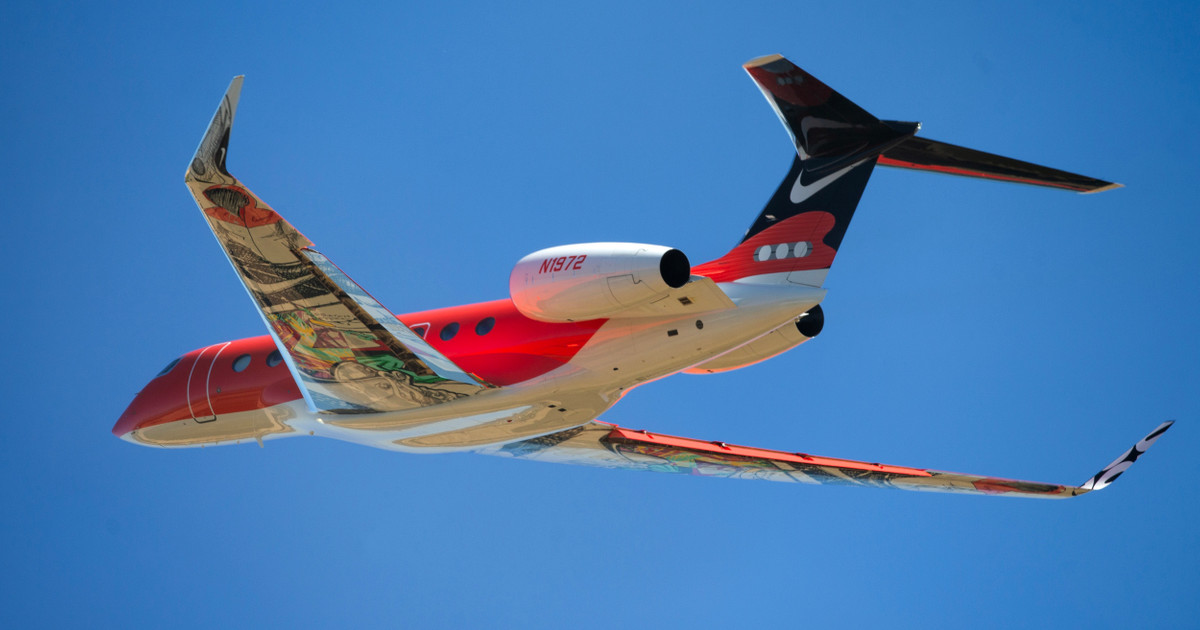This story was produced in partnership with The Oregonian/OregonLive. ProPublica is a nonprofit newsroom that investigates abuses of power. Sign up for Dispatches, a newsletter that spotlights wrongdoing around the country, to receive our stories in your inbox every week.

Nike, the world’s largest athletic apparel brand, has moved to hinder public scrutiny of its corporate jets after ProPublica and The Oregonian/OregonLive highlighted executives’ travel destinations. In doing so, it became the latest participant in a cat-and-mouse game of jet owners seeking to cloak their movements around the globe.
A month after the story’s publication, Nike’s two Gulfstream G650ER jets were no longer visible on the flight tracking website FlightAware. Both were added to the Federal Aviation Administration’s Limiting Aircraft Data Displayed list, consisting of planes that sites like FlightAware are not allowed to show. Placement on the list makes it harder — but not impossible — to see where the planes are going.
We reported that Nike’s private jets last year emitted almost 20% more carbon dioxide than they did in 2015, which the company uses as a baseline for its climate goals. The planes are one small reason Nike and its supply chain produced roughly as much carbon dioxide in 2023 as in 2015, despite the company’s voluntary commitment to sharply reduce emissions.
The website LADDlist.com first detected the block on one of the jets on Aug. 27, just two weeks after the article was published and days after flight records show the aircraft returning from a 10-day trip to Cape Cod, Massachusetts, where company executive chairperson Mark Parker owns a home. It’s unclear from LADDlist when the other jet was blocked, but it was visible on FlightAware as of Aug. 13.
A spokesperson for the FAA would not confirm the timing for either jet’s placement on the list, and Nike did not respond to questions. The jets are still trackable via a different data source that ProPublica and The Oregonian/OregonLive used in their reporting.
Plane travel has been considered public information because taxpayers help fund the air traffic control system governing the common space, said Chuck Collins of the progressive Institute for Policy Studies.
Collins, who has studied the FAA’s secrecy programs, called Nike’s move an effort to avoid accountability. He said it amounts to Nike saying: “‘We don’t want ProPublica to bother us. We don’t want to show up in the newspaper.’”
A precursor to the LADD list, which contained the names of 1,100 jet owners who wanted their travel hidden, was private until ProPublica fought in court to obtain it from the FAA. After the news organization reported on the program’s participants in 2010, the FAA said it would require plane owners to demonstrate a valid safety concern to block tracking. But, under pressure from Congress and from lobbying groups for pilots and plane owners, the FAA soon dropped the requirement.
The list of blocked tail numbers has since exploded. It now encompasses 52,000 planes, or 24% of all registered aircraft in the nation, according to FAA records obtained in January by the Institute for Policy Studies.
The National Business Aviation Association, which represents corporate jet owners, cited privacy as a key reason for the program’s existence. “People shouldn’t be required to surrender their right to privacy, safety and security from corporate espionage just because they board an aircraft,” association spokesperson Dan Hubbard said.
Passenger manifests are not public.
A variety of celebrities have protested the disclosure of their jet travel by people and groups bringing attention to their carbon emissions. After a college student posted the whereabouts of Elon Musk’s jets on X, the social media platform Musk owns, Musk tried to buy the account, then suspended the student temporarily.
Nike executives’ travel remains visible through other means, thanks to a transponder technology known as automatic dependent surveillance-broadcast, or ADS-B, which was implemented as part of an FAA move to a more precise, next-generation air traffic control system. ProPublica and The Oregonian/OregonLive used transponder records from a site called ADS-B Exchange to track flights by Nike’s jets.
Some of the news organizations’ reporting focused on the travels of CEO John Donahoe, a former Silicon Valley tech executive who maintained a home in the Bay Area after starting at Nike. Airports near his home became a magnet for Nike’s jets during his tenure.
The morning after former Nike executive Elliott Hill was named as Donahoe’s replacement on Sept. 19, a Nike jet’s transponder reported the plane departing from the Portland area, records show.
With a moving van posted outside Donahoe’s downtown Portland condominium building, the jet climbed to a cruising altitude of 41,000 feet, landing in San Jose, California, less than 24 hours after Donahoe’s exit was announced.

